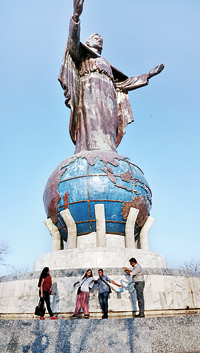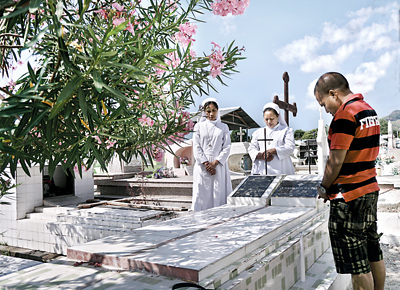A crocodile legend and the Cristo Rei of Dili
View(s):The mountains too are never far-away in Dili and while delegates to a health conference, with some trepidation, talk of how a crocodile was seen waddling along the street close to an embassy, the inextricable bond between these reptilians and Timor-Leste is not only heard but also seen.
Almost all those in Dili are quick to point out the undulating terrain with the mountains taking the shape of a huge crocodile, its snout tapering towards the sea and its scaled-back towards land.

Photo opportunity: Sightseers pose for photos at the foot of the iconic Cristo Rei
Legend has it that a child, nearly dead of starvation, was weeping on the beach when out of the sea came a crocodile, not to take the little one as prey but to find food for the child.
A close friendship grew, thereafter, and when finally the crocodile died, it had turned over, forming the land of Timor-Leste which then took its shape.
It is on the crocodile’s head looking benevolently out to sea with arms outstretched is Cristo Rei of Dili (Christ the King of Dili), like Christ the Redeemer in Rio de Janeiro, Brazil.
This iconic 27-metre statue, commissioned by Indonesia’s President Suharto when Timor-Leste was still its 27th province had been designed by Mochamad Syailillah, better known as Bolil.
Christ standing on a globe, located on the Fatucama peninsula is not only a major tourist attraction but also a haunt of locals. Some say the steep climb is 500 steps but others that it is 600+ and I give up halfway, along the path which also depicts the Stations of the Cross (Christ’s agonized journey up Mount Calvary, carrying the cross), shamed into embarrassment to see heavily-expectant mothers and even toddlers who make the ascent seem so easy.
Some have made it an exercise ordeal and run up and down agilely. Others divert from the well-trodden path after the Stations of the Cross to spend some quiet time on the beach known as ‘Jesus Backside’.
We learn from our guide that in Timor-Leste’s interior there is the highest peak of Ramelau or Tatamailau with a striking-statue of the Virgin Mary.
Another must-see that the Timorese people point out sadly but proudly is the Santa Cruz Cemetery where lie buried freedom fighters shot down by Indonesian soldiers. The massacre of more than 200 people in 1991 had followed a peaceful procession after a leader whose statue can be seen prominently, had been killed earlier.

Santa Cruz cemetery: A silent prayer for a dear-departed
Another important stop is the ‘Timorese Resistance Archive & Museum’ established in 2005. Within its squat building is preserved the memories of the resistance struggle and a replica of the tiny cell of Xanana Gusmao, with a rickety typewriter and his sparse possessions.
“According to official Indonesian statistics, Timor-Leste had 653,211 inhabitants in 1974. In 1978, the figure had dropped to 498,433. This means that Timor-Leste had lost more than 23% of its population in four years of Indonesian occupation,” states a leaflet, giving the magnitude of the tragedy.
Gusmao went on to become the first President of independent Timor-Leste, then Prime Minister and is now a minister.


